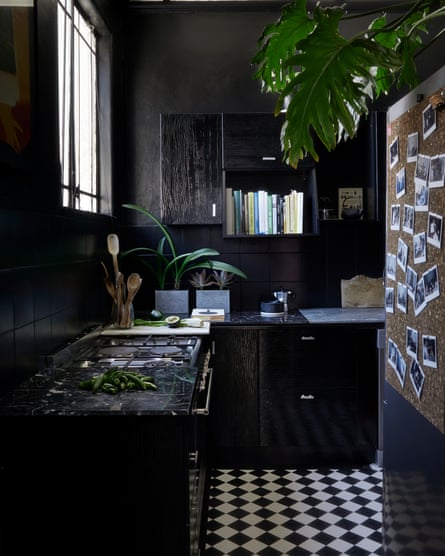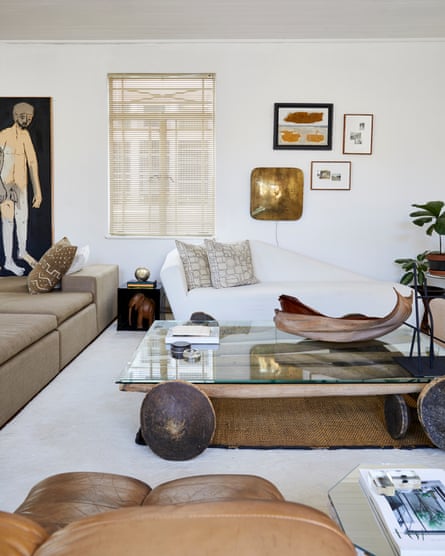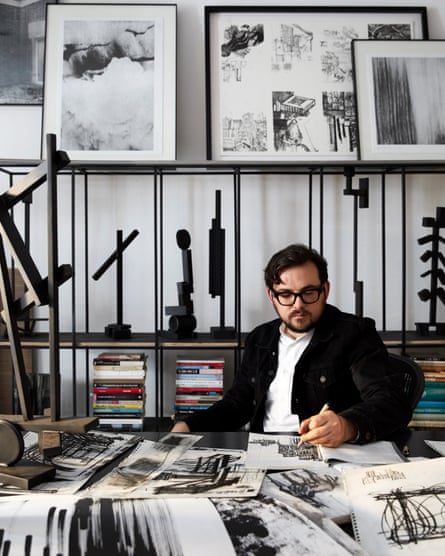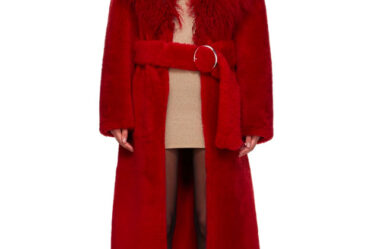
It was perhaps inevitable that sculptor Rodan Kane Hart and his partner, interior curator Maybe Corpaci, would treat their home as an experimental space. As much a home, studio and refuge, it is also a constantly evolving creative outlet for their ideas and collections of art and design.
On the sixth floor at the top of a 1930s building, originally built for a shipping company, the apartment is in Cape Town’s central business district. A polished granite plinth, ornate turret and richly decorated cornice speak of an era of opulence and prosperity. The black and white marble entrance hall leads to a teak-panelled shipping room, while arched doorways and parquet floors are found throughout. Rodan and Maybe were attracted as much by the grandeur – allowing Rodan to have his studio at home, as well as providing ample space for furniture – as by the period detailing.
The entrance hall is home to a Saruyama Island two-seater sofa and settee, both by Toshiyuki Kita for Moroso. A pair of Ant chairs by Arne Jacobsen for Fritz Hansen are positioned below an artwork by Unathi Mkonto.
In the lounge and dining area, Brazilian designer Percival Lafer’s modular sofa is combined with a Tuareg bed used as a coffee table. Artworks include those by Brett Charles Seiler and Rodan himself.
Rodan began collecting furniture in his 20s. “I’d sell a few artworks and buy furniture,” he says. His gradually expanding collection of largely midcentury pieces worked well in the kind of warehouse lofts he’d occupied before moving here, but found fresh expression in this more commercial space. Maybe adds that the apartment left them with “a lot of space to fill” when they first moved in.
She says that their apartment grew around the furniture rather than from an interior design concept or preconceived idea. Their creative energies have been devoted to figuring out how to combine and recombine individual pieces.

“It starts with one piece and then we create a narrative around it,” says Maybe. “It happens quite organically. There’s nothing that’s premeditated about it, or specific to a layout that we stick to.”
Pieces were never bought to match, but rather for their own merit and interest. Inevitably, they’ve been drawn to works that resonate with others they already own, but that’s about as strategic as their approach ever got. And not everything is collectible. “We love a bargain,” says Maybe. They picked up the dining table for next to nothing at an auction and had it ebonised to give it a new lease of life. “It just worked in the space and we’ve grown around it,” say Rodan.
The kitchen features black and white checked linoleum floors and Tokyo stools by British designer Rodney Kinsman for Bieffeplast, originally designed in 1985 for London’s Groucho Club.

The root of Rodan’s interest stems from his notion of furniture as functional art – a practical manifestation of what he explores through sculpture.
Rodan suggests that, whereas art often seems purely emotional, furniture design, perhaps because it is practical, retains a narrative quality that he loves – a kind of patina of use.
“I think architecture and design are fields imbued with history and experience,” he says.
The apartment is very much a meeting of two individual styles – Maybe’s in soft whites, creams and beiges in, for example, the living room, while Rodan’s preferences are, she says, “angular, black and chrome”.

While Rodan and Maybe’s home might be a kind of personal creative laboratory, it’s also a testament to how life takes its own unexpected turns.
Rodan likens the process to something he encountered when collecting vinyl records – and an entire room of the apartment is devoted to his mainly punk albums. He says that collecting isn’t so much about the objects one pursues as the discoveries one makes along the journey. He thinks of all the other music he’s unearthed in pursuit of one particular record or another, and the richness the journey brings.
This is why its so important there’s no end in mind. “It’s never finished,” Maybe says of their apartment. “It’s a playground, an experimental place where there are no mistakes.” This experiment is about inspiration, new interests and adding another layer of history.



